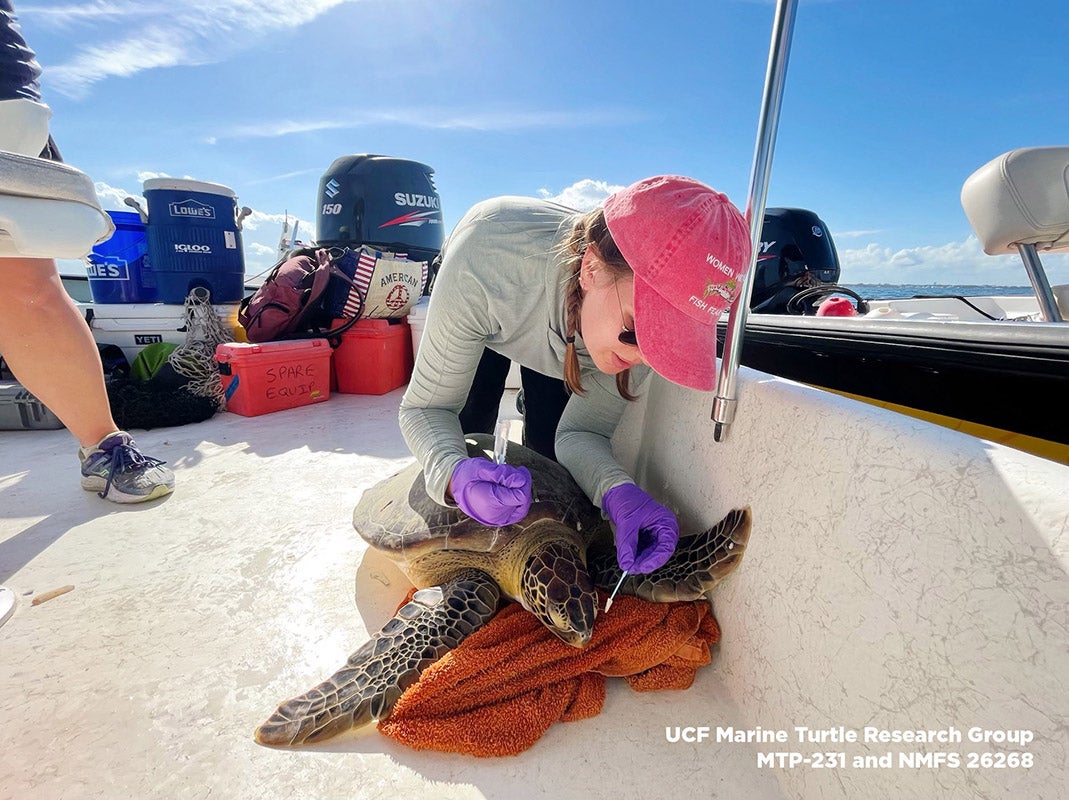The remarkable ability of migratory animals to navigate and remember routes may be attributed to their sensitivity to not only the Earth’s magnetic field, but possibly also to interactions with the magnetic bacteria that live in the field.
The relationship between these magnetic bacteria and the animals they live in is not yet fully understood, but Robert Fitak, an assistant professor of biology at UCF, recently compiled a database of animal DNA. This database contains hundreds of millions of sequences that indicate the presence of different types of magnetic bacteria. He can use it to help him in his quest to learn more.

The database marks a step forward in his research and builds on earlier hypotheses and analyses he published in 2020 in collaboration with colleagues in the United Kingdom and Israel.
In 2021, Fitak continued to comb through databases to categorize which animals might harbor magnetic bacteria and whether there were any common patterns.
“The first study we did was look at existing datasets and summarize where we found these bacteria in different animals,” he says. “We looked at about 50,000 previous scientific studies. Now we’ve expanded that to looking at a global database of genetic information and we’ve been able to summarize where these bacteria are based on trillions of genetic sequences.”
The database was published earlier this year in Data in briefand borrows information from the publicly available Sequence Read Archive of the National Center for Biotechnology Information.
Fitak focused on sequencing DNA sequences from different animal species that match known magnetic bacteria. He and other researchers wanted to use this to refine their research into the role of magnetic bacteria in the environment and ecology, or to identify potential animal hosts.
An internal compass?
Fitak and his colleagues are using the refined data to identify potential host organisms for the magnetic bacteria and to provide more context for investigating the roles they may play in animals, such as in navigation.
“Ultimately, if we understand better how animals navigate, it will be useful for the conservation of endangered or protected species,” Fitak says. “If we know where they go and how, it can help us make more accurate management decisions.”
He’s interested in seeing if the magnetic bacteria are in areas inside an animal that they can sense, such as parts of its nervous system. Fitak thinks they could serve as a navigational aid for animals, or provide an extra boost to creatures like birds or sea turtles that already use the Earth’s magnetic field to navigate long distances.
“It’s almost like a microbial compass, and we’re looking at how that might work,” Fitak said. “We think the animals are already using the Earth’s magnetic field as a compass.”
He also says another potential benefit is that scientists could study how animals perceive the magnetic fields and potentially mimic how they are used in different applications, such as drug delivery.
However, there is no conclusive evidence that these animals use the magnetic bacteria to navigate, Fitak says.
“The big takeaway from our research so far is that we don’t know yet whether these bacteria are detecting the bacteria for the animal, but we do have evidence that they are living in these animals,” he says. “But what we’ve learned is that we can use genetic tags that are signatures of bacteria that make magnets, and we’ve identified these genetic signatures of these bacteria in a variety of animals, including humans.”
These types of bacteria often live in sediments or mud where there is not much oxygen, Fitak says. They assemble microscopic and magnetized iron “chains” to help them move, he says.
It’s unclear how organisms acquire these bacteria, but the theory is that it could be through absorption or consumption, Fitak says.
“Our results in projects so far show that these magnetic bacteria appear to be a permanent part of the microbiomes of many species,” he says. “Hopefully, our future work will show whether they are only collected incidentally from the environment, are a functional part of magnetic sensing for a host animal, or are there for some other unknown reason.”
Focus on sea turtles
Fitak and his team of student researchers are focusing on examining samples from green sea turtles and loggerhead sea turtles to further study magnetic bacteria.
“Sea turtles are kind of a model for animal navigation,” he says. “We tested our hypotheses on sea turtles, because they travel very precisely to very specific places.”
Focusing on sea turtles was a logical next step, since they are known to harbor magnetic bacteria and rely on the Earth’s magnetic field to migrate, Fitak says. UCF’s Marine Turtle Research Group has also been instrumental in obtaining turtle samples, he says.
Julianna Martin, a PhD candidate working with Fitak, helped analyze and collect the nearly 150 sea turtle samples.
“I work in the lab to extract the DNA from the samples and use genomics to identify which bacteria are in the samples and which are the magnet-forming bacteria that we’re looking for,” she says. “I couldn’t have collected the samples without the help of the UCF Marine Turtle Research Group. It’s been a team effort.”
Martin and scientists from UCF’s Marine Turtle Research Group carefully collect tear samples with soft cotton swabs from nesting female turtles — which enter a near-trance-like state while laying eggs — and from hatchlings in the Indian River Lagoon.
The turtles produce large, slimy tears when they are on land to keep their eyes moist. The tears take about 30 seconds to collect, Martin says.
“We started with the tear ducts because they are connected to nerves that are possibly associated with the magnetic senses of animals,” she says. “Biologically, it makes sense to look there, and it’s easy to collect sea turtle tears.”
Martin says she’s pleased with the progress they’ve made so far, but she hopes this momentum will move their research toward more definitive conclusions.
“This research is really exciting,” she says. “No one had specifically looked for this in sea turtles. I’m interested in knowing where they come from and what kind of magnet-forming bacteria each sea turtle species has. It’s a long way off, but for now we’re working on describing ‘are they there?’ and ‘where do they come from?'”
According to Fitak, the potential to share the unique discovery of magnetic bacteria that help animals navigate is truly miraculous.
“What’s exciting is that I can tell people that there are bacteria in this world that make magnets,” he says. “People are amazed, and it would be incredible if animals actually used these magnetic bacteria to navigate.”
Fitak encourages researchers interested in studying magnetic bacteria to examine the data he has collected.
All sea turtle samples were collected under UCF MTRG protected species permits (MTP-231, MTP-171, and NMFS 26268)
Research references
Fitak is an assistant professor in UCF’s Department of Biology in the College of Sciences. He received his doctorate in genetics from the University of Arizona and his bachelor’s degree in molecular genetics from The Ohio State University. Before joining UCF in 2019, he worked as a postdoctoral researcher at the Institute for Population Genetics in Vienna, Austria, and at Duke University. He is a member of UCF’s Genomics and Bioinformatics research cluster.
Martin is a UCF biology Ph.D. student who plans to continue her genetics research at the university. She earned her undergraduate degree from St. Mary’s College of Maryland and worked at the American Genome Center at the Uniformed Services University.
